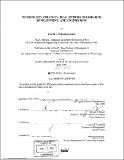Technology strategy : real options in research, development and engineering
Author(s)
Wesolowski, Piotr J., 1956-
DownloadFull printable version (9.076Mb)
Other Contributors
Massachusetts Institute of Technology. Management of Technology Program.
Advisor
Stewart C. Myers and James M. Utterback.
Terms of use
Metadata
Show full item recordAbstract
This thesis develops a framework for valuing projects in research, development and engineering (R,D&E) environments using real options valuation (ROV) concepts. It proves that the often-used discounted cash flow (DCF) techniques do not properly capture the uncertainty and flexibility of platform projects in technology-intensive industries. First the thesis presents the technology strategy that relates to value creation, value delivery, and value harvesting in high-tech companies. Analysis of the innovation dynamics models concludes that a sustainable competitive advantage in high-tech firms is most successfully achieved via high appropriability and development of a large set of complementary assets. The thesis also shows that a firm should use a mix of those assets depending on the technology development stage. Next the thesis investigates profit extraction in depth. The thesis describes how real options theory can be used to value most representative projects in technology-intensive firms, such as creation of intellectual property, development of breakthrough technology, and acquisition of platform technology. Based on ~ literature survey and the character of the last two projects analyzed, it is argued that multi-staged investment outlays are most accurately analyzed by using compound real options. An analytical compound options model is introduced and successfully implemented to value two real-life technology projects. Along with a mathematical analysis of the call on call options model, the thesis shows a proper way to discretionize investment outlays to perform an accurate valuation. ROV of technology cases with embedded options characteristics has significant strategic · consequences for high-tech firms. In the final part the thesis presents an approach to value , and dynamically manage a portfolio of high uncertainty technology projects. It is argued that R,D&E management can use ROV techniques to improve a sustainable competitive position and optimally develop its mid- and long-term technology strategy. The thesis discusses in-depth the managerial implication of ROV and the necessary ingredients to implement the real options framework into the corporate strategy.
Description
Thesis (S.M.M.O.T.)--Massachusetts Institute of Technology, Sloan School of Management, Management of Technology Program, 2000. Includes bibliographical references (leaves 97-102).
Date issued
2000Department
Management of Technology Program.; Sloan School of ManagementPublisher
Massachusetts Institute of Technology
Keywords
Management of Technology Program.